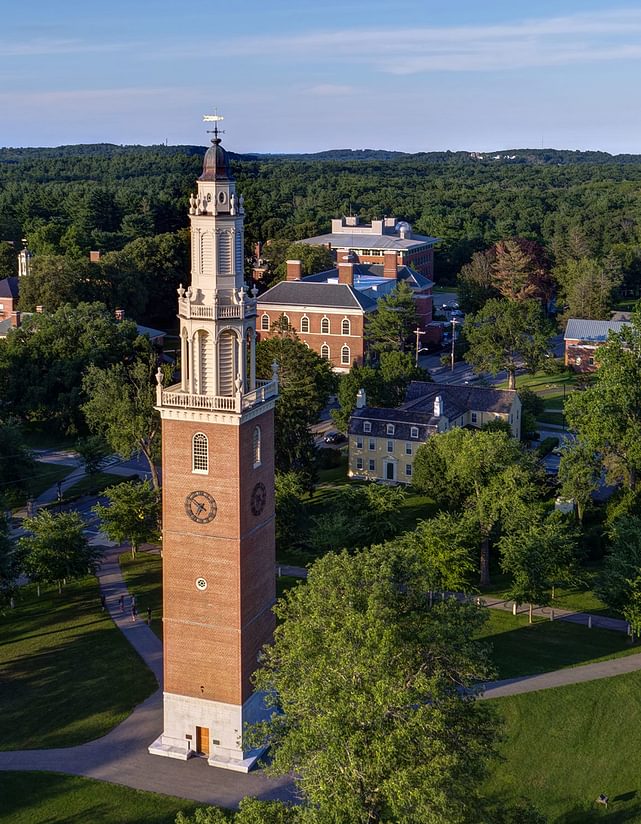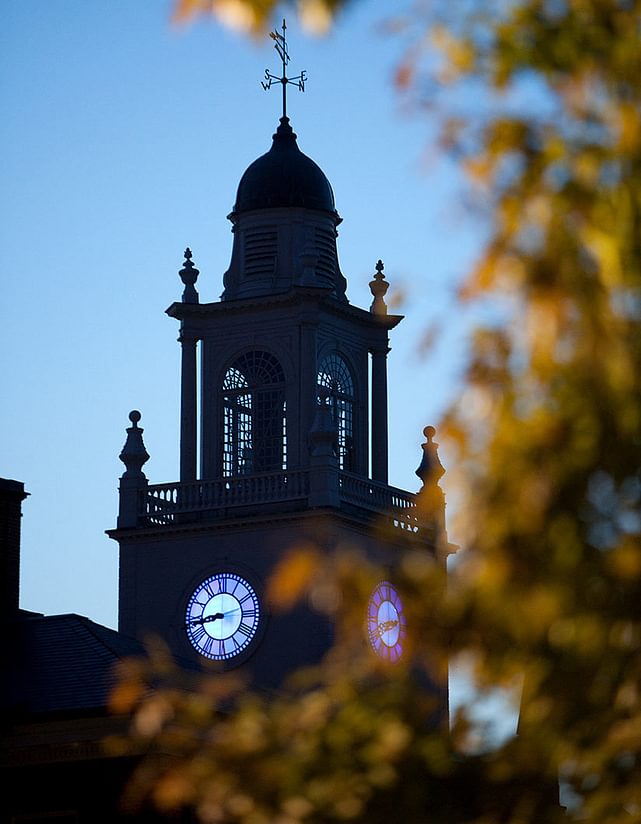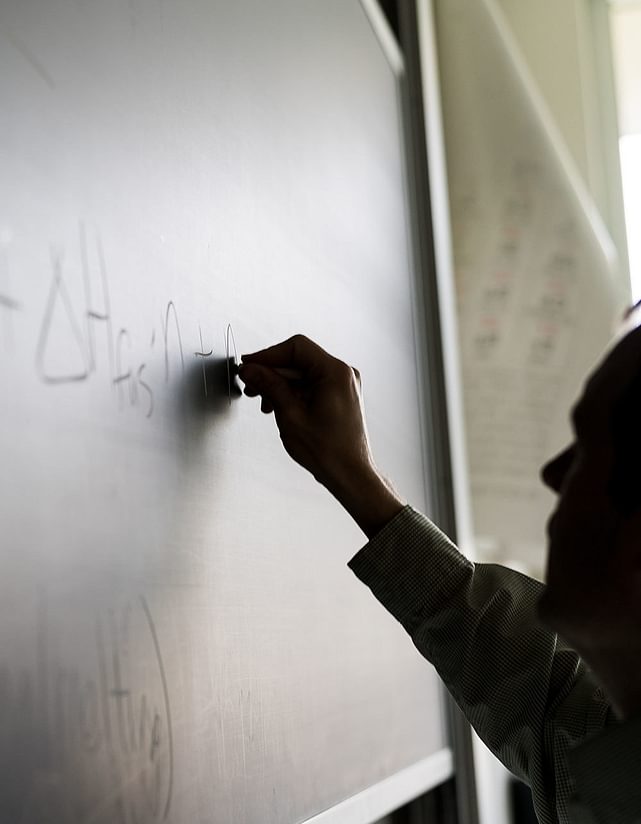AAF Impact Report 2023
REFLECTIONS ON THE AAF’S FIRST 50 YEARS:
A LETTER FROM THE AAF PRESIDENT
In 1973, when Mel Chapin, Myndie Nutting, Beverly Floe, and Phil Allen hatched a plan to set up a million-dollar fund, who could have imagined that it would blossom into a $13 million endowment that has given over $15 million and 1,600 grants to benefit the Andover community? Through the Abbot Academy Fund, Abbot’s values of boldness, innovation, and caring have lived on in campus life and beyond. There is hardly a place or program or innovation at the school that wasn’t inspired or touched by an AAF grant.
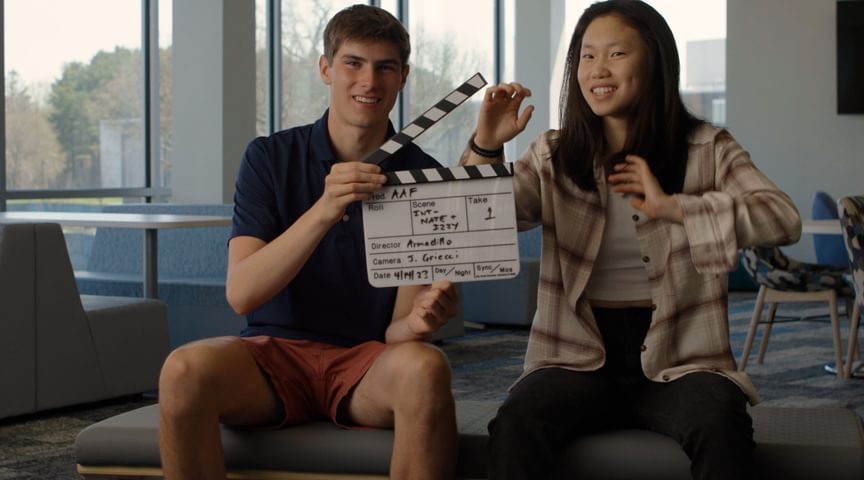
Abbot Hoops grant recipients behind-the-scenes in “Dream It, Do It” film
The AAF Board of Directors, made up of alumni/ae from both Abbot and Andover, works with the school to be responsive to changing needs and trends. We award large and small grants—to faculty, students, and staff—for projects and programs that reflect the values and spirit of Abbot, and remind everyone of the long history and traditions of what was, in 1973, the oldest girls’ academic boarding school in the country.
To acknowledge the AAF’s 50th anniversary, we are very proud to present this report on the fund’s impact. We hope you also enjoy the film, “Dream It, Do It: The Abbot Academy Fund's First 50 Years,” which you can view on the Abbot Academy Fund page.
Beth Humstone ’66
Abbot Academy Fund President
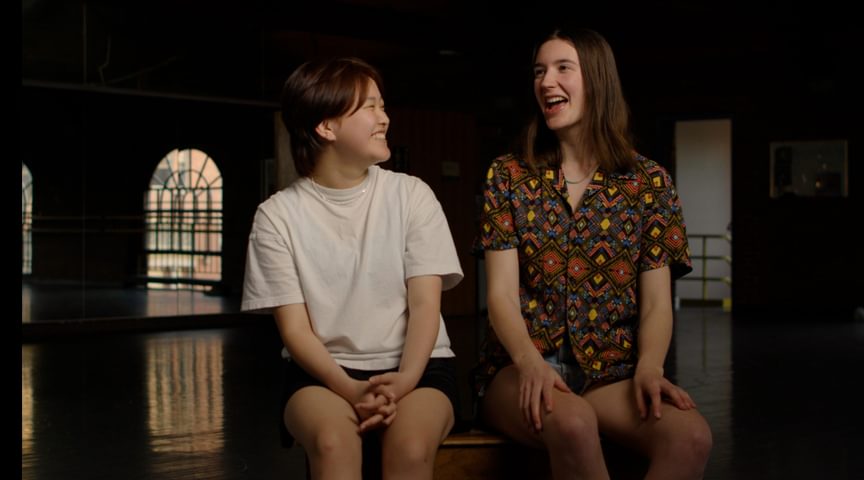
Tap Shoe Lending Library grant recipients
AAF NUMBERS THROUGH THE DECADES
The AAF’s endowment began with $1 million and has grown steadily—as has the number of grants awarded.
The chart below (top) shows the total dollar amount of AAF grants by decade. The second chart (bottom) shows the total number of grants given by decade. Because record-keeping in the early days of the fund was inconsistent at times, the data from the ’70s to ’90s are our best estimates.
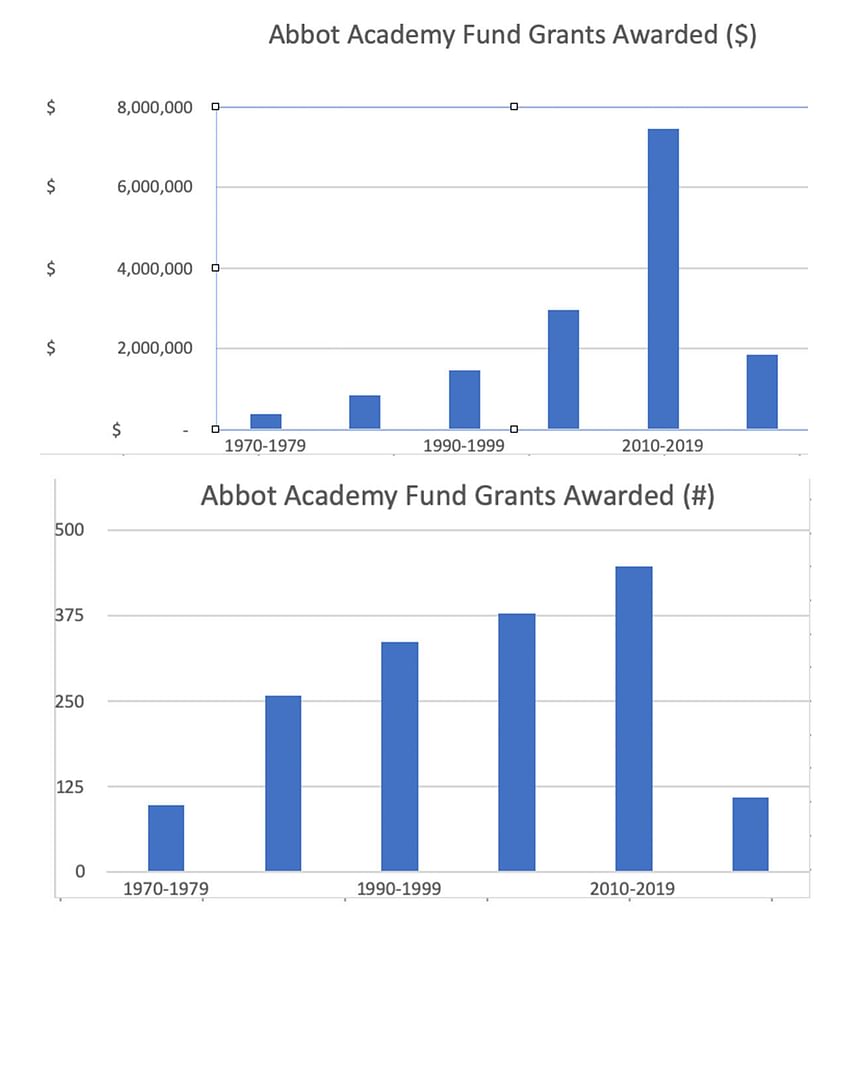
SURVEY SAYS…
In October 2022, the AAF board sent a survey to 500 past grant recipients from all five decades. Below are the compiled responses from students (top) and faculty and staff (bottom). Note that the survey included ratings for Disagree and Strongly Disagree, but none of the respondents chose those options.
My Abbot Academy Fund grant had a positive impact on:

RECURRING GRANT THEMES
Since 1973, the AAF has awarded more than 1600 grants to Phillips Academy students, faculty, and staff. Grants are given for projects, programs, and activities that reflect the Abbot values of boldness, innovation, and caring.
Grants have been awarded in many categories, including academics, community outreach, performing arts, philanthropy, and athletics. In considering all the awarded grants, some common themes emerge. Below are some of the most noteworthy.
Academics
More AAF grants fall into this category than any other. As mentioned in the Community Building section, AAF grants provided the foundation for the Psychology and Philosophy departments. AAF grants also led to the creation of an Ethics course, an observational astronomy program (an AAF grant paid for a new telescope), a PC training program for faculty, and an Arabic language program. Seminars, workshops, lectures, and other kinds of training have been offered in nearly every subject area. AAF funds have been used to purchase numerous classroom materials, including audiobooks and other media to aid students with visual or other disabilities.
Many academic-themed grants have addressed equity and inclusion issues. For example, in 2019, a group of female math and science teachers, concerned that girls weren’t being encouraged to take advanced STEM courses, used a grant to hold a professional development conference on campus, where faculty explored unconscious bias issues. A similar conference was developed by the college counseling office.

Phillips Academy Astronomy students in the PA Observatory
Campus Community Building
After the merger, when PA faced the challenge of integrating hundreds of female students—and total enrollment was at its highest—AAF provided grants that led to the development of the cluster system. These school “neighborhoods” helped students (including non-boarding students) feel an immediate sense of community and belonging. AAF grants provided training for house counselors as well as cluster-branded clothing and activities. The cluster system is still thriving as an effective way of creating community within the school.
Other examples of on-campus community-building AAF projects include:
- In 2007, an AAF grant sponsored the first Non Sibi Day, with the purpose of uniting “the entire Phillips Academy community through community service projects that will take place locally, across the nation, and around the world
- In 2016, professional experts were hired to provide workshops on Bystander Training for Gender-Based Violence.
- The CAFE (Community Awareness for Everyone) program, begun in the early 2000s, hosted evening social discussion groups to promote cross-cultural awareneess. CAFE continues now as Out of the Blue, an anthology of personal reflections on diversity and inclusion.
- Sandra Morales Lopez ’97, who PA later hired as a psychologist, used an AAF grant to establish New Upper Suppers. Remembering her own experience coming to PA in 11th grade, Lopez provided a community where new uppers could support each other as they integrated into campus life.
Clubs and Publications
Computer hackers, Korean drummers, public speakers, future physicists, chess players, ice skaters, creative writers, electronic musicians, debaters, architects . . .Name an interest, and chances are there’s a PA club for it. And chances are that the club received some kind of support for AAF, such as money for books, equipment, travel, and entrance fees.
The AAF has also helped establish various magazines and newspapers focused on topics such as literature classics, cooking, photography, and politics.
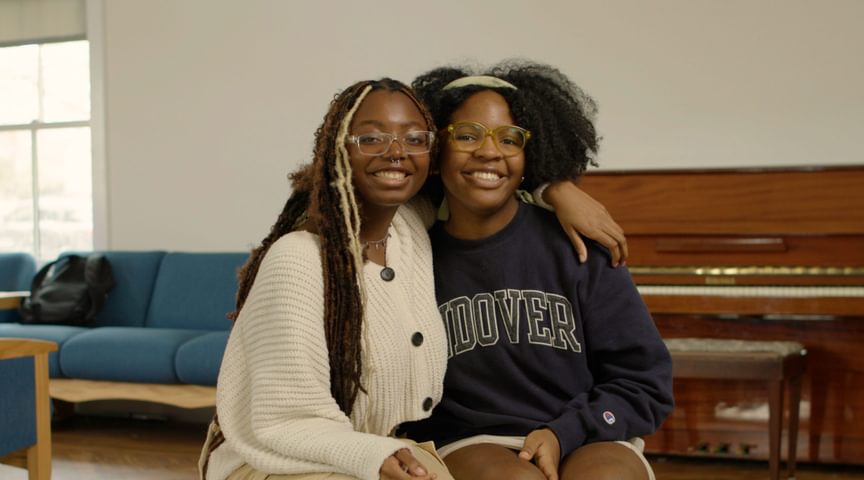
Curly Hair Club grant recipients
Diversity, Equity, and Inclusion
At the time of the merger, most DE&I efforts focused on the immediate need to incorporate girls into the school. AAF funded at least one study, carried out by a faculty member, that was designed to observe, evaluate, and make recommendations for successfully integrating female students.
In subsequent years, applications for DE&I-related AAF grants aligned closely with social changes and events happening throughout the country and world. Hundreds of grants were given in response to or to support causes such as civil rights, Matthew Shepherd’s murder, the Americans with Disabilities Act, the 9/11 attacks, sexual identity, and Native American land acknowledgment. A few examples follow.
- Shortly after the merger, the AAF funded a study to recommend a program for effectively recruiting minority students.
- Grants were awarded to create Black Arts Weekend, Latin Arts Weekend, and Caribbean Heritage Weekend. Typically, these events feature speakers, mixers, cultural performances, and other relevant activities.
- AAF grants funded speakers, conferences, and curriculum development addressing homophobia.
- The Brace Center for Gender Studies has received ongoing support from the AAF. According to the Brace Center website, the center “exists, in part, due to the generous ongoing support of the Abbot Academy Fund, continuing Abbot Academy’s tradition of boldness, innovation, and caring in education.”
- AAF funded the pilot program for the CAMD (Community and Multicultural Development) pilot project. Students submit proposals for addressing an issue affecting a marginalized group (the CAMD application process mirrors the one established by AAF). Under the mentorship of a faculty advisor with expertise in the area, the students research the issue and present their findings at a public forum on campus. The Out of the Blue publications are also CAMD student projects.
Facilities
No matter where you are on the PA campus, you’re probably within a few feet of a space that's been updated, refurbished, renovated, remodeled, or otherwise improved with AAF grants. Examples of areas that have been created or upgraded include Benner House, Cochran Chapel, the chapel cemetery, Gelb Art Gallery, Graham House, Harrison Ice Rink, the Makerspace, Morse Hall, the Physics Mechanics Lab, children’s playgrounds, and the Peabody Museum.
The new Abbot Hoops outdoor basketball court installation was completely driven by two students and fully funded by the AAF. As mentioned in the Performing Arts section, the soon-to-be-built music building, Falls Hall, received a large grant from the AAF, and the Abbot Academy Dance Suite in the new Pan Athletic Center were fully funded by the AAF.
AAF grants have also provided the school with supplies such as computers, theater costumes, radio station equipment, cluster flags, and more.
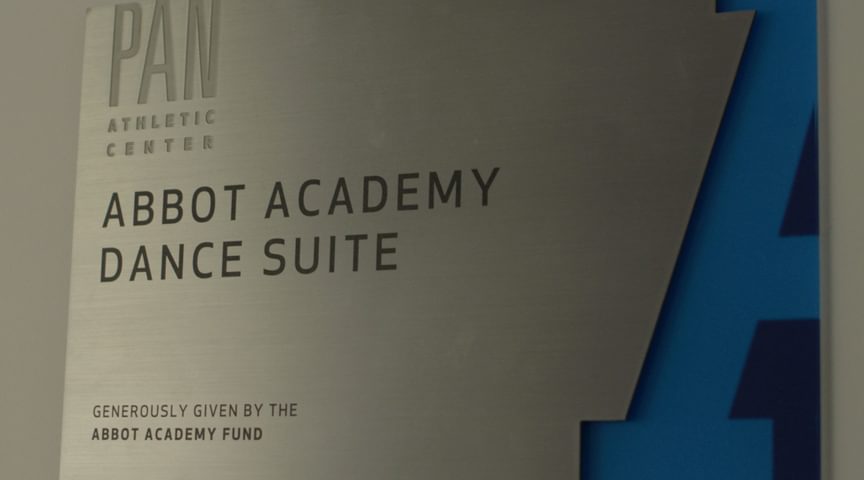
Dedication plaque for Abbot Academy Dance Suite
Historical Preservation, Archiving, and Museums
AAF grants have helped preserve numerous documents and other paper-based records of historical importance. Record-keeping and archiving methods have changed frequently over the past 50 years, and many AAF grants have been awarded to convert films and other outdated media. For example:
- In 2001, funds were awarded to transfer historical films of Abbot and Andover to DVD format. The 116mm films were beginning to corrode.
- In 2018 and 2019, AAF grants supported the transcription of the Peabody Institute’s original early catalog ledger books, from a single line of hand-written text into a spreadsheet tool enabling various activities, such as augmenting catalog records, selecting material for use in classes, and identifying items for repatriation.
- AAF funds have been awarded to digitize the entire collection of The Phillipian.
In addition, the AAF has provided funding for professional appraisals of the academy’s antiques and artifacts.
Outreach and Philanthropy
One of the most visible examples of the AAF’s support for communities outside of the school is Andover Bread Loaf (ABL), whose mission is to “promote literacy and educational revitalization through the lens of social justice in the most under-resourced communities and school systems around the world.” In 1984, the AAF funded a summer English Study Institute for teachers from urban public schools; that program later became the Andover Bread Loaf Institute. AAF has been a loyal ABL donor ever since, helping establish new programs in Haiti, Puerto Rico, and other locales.
AAF grants have also supported PALS—Phillips Academy, Andover, and Lawrence Schools—a program that brings together middle schoolers and volunteers from PA and Andover High School. PALS participants help younger students with academic enrichment and study skills and provide support for a successful transition to secondary school.
Since its inception, the AAF has offered scholarships that have helped students and teachers participate in a variety of activities, including School Year Abroad, summer language programs in foreign countries, conferences, and coaching clinics. AAF also provides a yearly tuition scholarship and has offered financial aid to help 11th graders take tours to visit potential colleges.
Performing Arts
Throughout its five decades, the AAF has funded many programs in music, dance, and theater. A few examples:
- The Abbot Academy Dance Suite at the new Pan Athletic Center were entirely funded by a large AAF grant. These spaces are named for Cristina Rubio, a well-loved ballet teacher who brought the Dance Department from Abbot to PA.
- AAF funds have purchased numerous professionally executed costumes and set designs for theatrical performances.
- In 1997, AAF grants paid for professional symphony musicians to join the school orchestra for Nutcracker performances.
- In spring 2022, a student grant funded sheet music for an all-student performance of Mozart’s Requiem. Approximately 40 students participated, with representation from all 4 years.
- Recently, the AAF pledged $1.25 million dollars toward the construction of a state-of-the-art music building. The Abbot Academy Fund will be acknowledged in the entryway area, a gathering and greeting space.
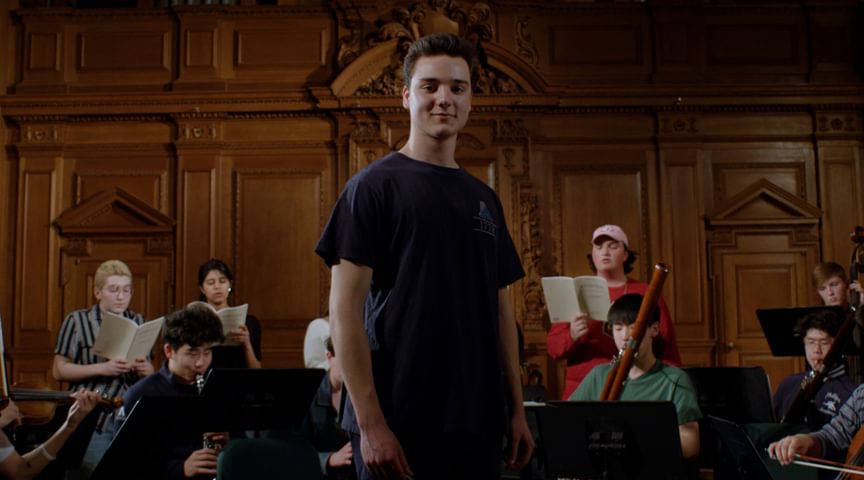
Students at “Mozart’s Requiem” performance
Wellness
Abbot was ahead of its time in recognizing that students’ overall wellness—emotional as well as physical—is a factor in maximizing their potential. For the first two years after the merger, AAF funded the salary of a full-time clinical psychologist (who worked at Abbot before the merger) as well as two part-time counselors.
AAF grants enabled PA to create a sex education course, hire a dietician to provide nutritional guidance, and establish a wellness library with books, magazines, and other resources to help students deal with stress. Ultimately, these programs led to funding the salary for a full-time instructor to develop the Psychology Department, which is still going strong, and offers elective academic classes.
Other examples of AAF-sponsored wellness projects include:
- Team Building for Boys Under Pressure. In 2015, two male teachers started a weekly group to help boys improve their emotional health. The teachers discovered that, as the boys learned techniques for handling their feelings, their academic and athletic performance also improved.
- Therapy Dog Visitation Program. In 2019, during penultimate week (the week before final exams) each term, an AAF grant paid for special animals—dogs, bunnies, and cats—to come to campus every day, to snuggle and play with stressed students.
